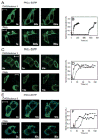Membrane-surface anchoring of charged diacylglycerol-lactones correlates with biological activities
- PMID: 20715268
- PMCID: PMC3729217
- DOI: 10.1002/cbic.201000343
Membrane-surface anchoring of charged diacylglycerol-lactones correlates with biological activities
Abstract
Synthetic diacylglycerol-lactones (DAG-lactones) are effective modulators of critical cellular signaling pathways, downstream of the lipophilic second messenger diacylglycerol, that activate a host of protein kinase C (PKC) isozymes and other nonkinase proteins that share similar C1 membrane-targeting domains with PKC. A fundamental determinant of the biological activity of these amphiphilic molecules is the nature of their interactions with cellular membranes. This study examines the biological properties of charged DAG-lactones exhibiting different alkyl groups attached to the heterocyclic nitrogen of an α-pyridylalkylidene chain, and particularly the relationship between membrane interactions of the substituted DAG-lactones and their respective biological activities. Our results suggest that bilayer interface localization of the N-alkyl chain in the R(2) position of the DAG-lactones inhibits translocation of PKC isoenzymes onto the cellular membrane. However, the orientation of a branched alkyl chain at the bilayer surface facilitates PKC binding and translocation. This investigation emphasizes that bilayer localization of the aromatic side residues of positively charged DAG-lactone derivatives play a central role in determining biological activity, and that this factor contributes to the diversity of biological actions of these synthetic biomimetic ligands.
Figures






Similar articles
-
Membrane anchoring of diacylglycerol lactones substituted with rigid hydrophobic acyl domains correlates with biological activities.FEBS J. 2010 Jan;277(1):233-43. doi: 10.1111/j.1742-4658.2009.07477.x. Epub 2009 Dec 3. FEBS J. 2010. PMID: 19961537 Free PMC article.
-
Conformationally constrained analogues of diacylglycerol. 26. Exploring the chemical space surrounding the C1 domain of protein kinase C with DAG-lactones containing aryl groups at the sn-1 and sn-2 positions.J Med Chem. 2006 Jun 1;49(11):3185-203. doi: 10.1021/jm060011o. J Med Chem. 2006. PMID: 16722637
-
Conformationally constrained analogues of diacylglycerol (DAG). 27. Modulation of membrane translocation of protein kinase C (PKC) isozymes alpha and delta by diacylglycerol lactones (DAG-lactones) containing rigid-rod acyl groups.J Med Chem. 2007 Mar 8;50(5):962-78. doi: 10.1021/jm061289j. Epub 2007 Feb 7. J Med Chem. 2007. PMID: 17284021
-
Synthetic diacylglycerols (DAG) and DAG-lactones as activators of protein kinase C (PK-C).Acc Chem Res. 2003 Jun;36(6):434-43. doi: 10.1021/ar020124b. Acc Chem Res. 2003. PMID: 12809530 Review.
-
C1 domains exposed: from diacylglycerol binding to protein-protein interactions.Biochim Biophys Acta. 2006 Aug;1761(8):827-37. doi: 10.1016/j.bbalip.2006.05.001. Epub 2006 May 13. Biochim Biophys Acta. 2006. PMID: 16861033 Review.
Cited by
-
Molecular basis for failure of "atypical" C1 domain of Vav1 to bind diacylglycerol/phorbol ester.J Biol Chem. 2012 Apr 13;287(16):13137-58. doi: 10.1074/jbc.M111.320010. Epub 2012 Feb 18. J Biol Chem. 2012. PMID: 22351766 Free PMC article.
References
Publication types
MeSH terms
Substances
Grants and funding
LinkOut - more resources
Full Text Sources

